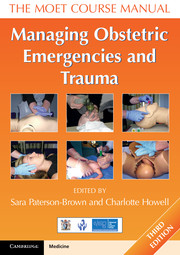Book contents
- Frontmatter
- Dedication
- Contents
- Working Group
- About the authors
- Acknowledgements
- Abbreviations
- Section 1 Introduction
- Section 2 Recognition
- Section 3 Resuscitation
- Section 4 Trauma
- Section 5 Other medical and surgical emergencies
- Section 6 Obstetric emergencies
- 24 Pre-eclampsia and eclampsia
- 25 Major obstetric haemorrhage
- 26 Caesarean section
- 27 Placenta accreta and retained placenta
- 28 Uterine inversion
- 29 Ruptured uterus
- 30 Ventouse and forceps delivery
- 31 Shoulder dystocia
- 32 Umbilical cord prolapse
- 33 Face presentation
- 34 Breech delivery and external cephalic version
- 35 Twin pregnancy
- 36 Complex perineal and anal sphincter trauma
- 37 Symphysiotomy and destructive procedures
- 38 Anaesthetic complications in obstetrics
- Section 7 Triage and transfer
- Section 8 Human issues
- Index
36 - Complex perineal and anal sphincter trauma
- Frontmatter
- Dedication
- Contents
- Working Group
- About the authors
- Acknowledgements
- Abbreviations
- Section 1 Introduction
- Section 2 Recognition
- Section 3 Resuscitation
- Section 4 Trauma
- Section 5 Other medical and surgical emergencies
- Section 6 Obstetric emergencies
- 24 Pre-eclampsia and eclampsia
- 25 Major obstetric haemorrhage
- 26 Caesarean section
- 27 Placenta accreta and retained placenta
- 28 Uterine inversion
- 29 Ruptured uterus
- 30 Ventouse and forceps delivery
- 31 Shoulder dystocia
- 32 Umbilical cord prolapse
- 33 Face presentation
- 34 Breech delivery and external cephalic version
- 35 Twin pregnancy
- 36 Complex perineal and anal sphincter trauma
- 37 Symphysiotomy and destructive procedures
- 38 Anaesthetic complications in obstetrics
- Section 7 Triage and transfer
- Section 8 Human issues
- Index
Summary
Introduction
Perineal trauma resulting from childbirth remains a common problem that is associated with considerable maternal morbidity, and may have a devastating effect on family life and sexual relationships. Following vaginal birth: more than 85% of women sustain perineal trauma, up to two-thirds need suturing and up to 30% sustain obstetric anal sphincter injuries (OASIS).
Many OASIS go unrecognised, and there is considerable under-reporting with incidences quoted as low as 1–2% of vaginal deliveries. Injury increases significantly in the presence of the following risk factors that often occur in combination: birthweight >4 kg; persistent occiptoposterior position; nulliparity; induction of labour; epidural anaesthesia; prolonged second stage >1 hour; shoulder dystocia; midline episiotomy and forceps delivery. Detection rates are increased by increased awareness and training, but ‘occult’ AS injury (i.e. defects in the AS detected by anal endosonography) from vaginal delivery is common and most commonly due to lack of recognition, with misclassification as a second degree tear.
Definition of perineal trauma
Perineal trauma may occur spontaneously during vaginal birth or as a result of a surgical incision (episiotomy), which is intentionally made to facilitate delivery. It is also possible to have both an episiotomy and a spontaneous tear.
- Type
- Chapter
- Information
- Managing Obstetric Emergencies and TraumaThe MOET Course Manual, pp. 417 - 428Publisher: Cambridge University PressPrint publication year: 2014



